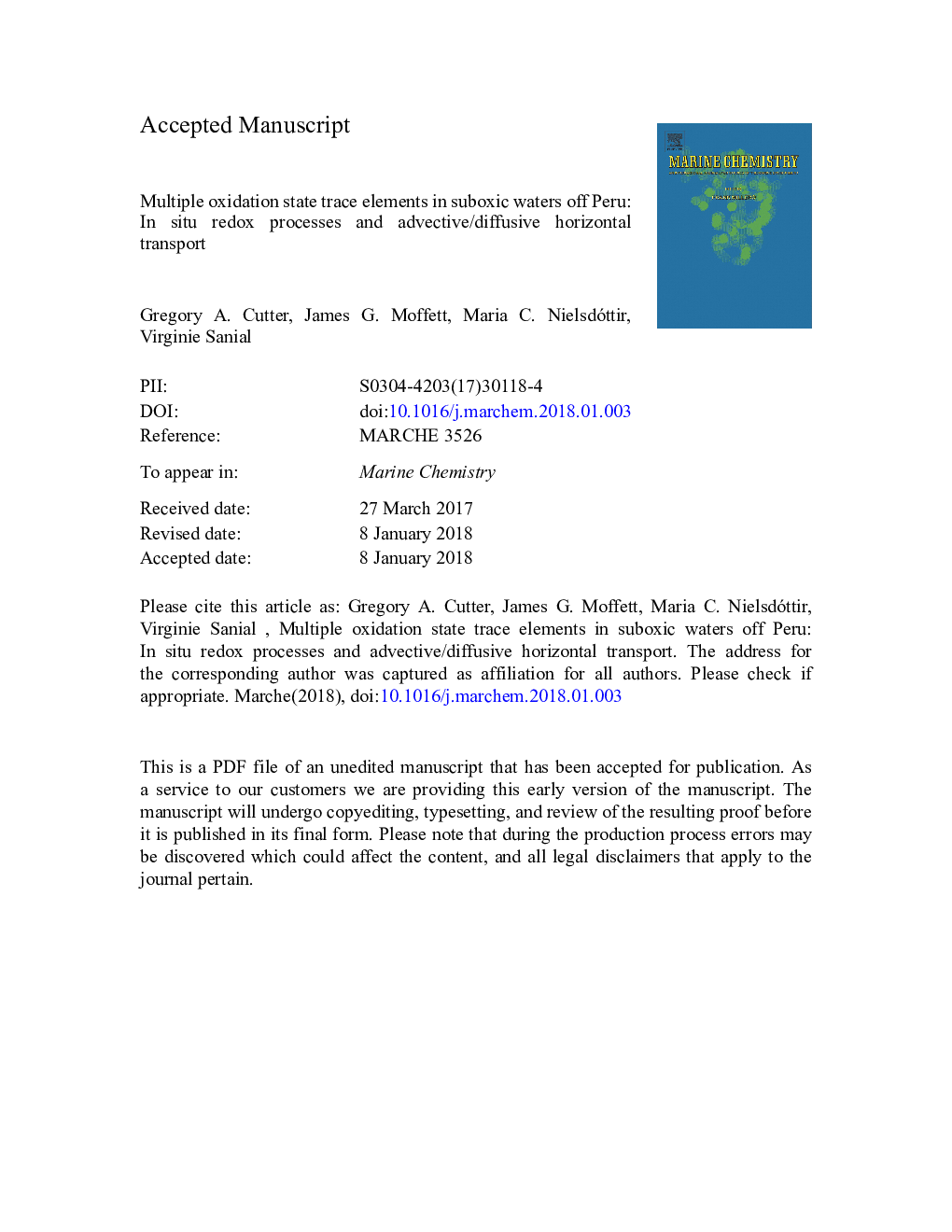| کد مقاله | کد نشریه | سال انتشار | مقاله انگلیسی | نسخه تمام متن |
|---|---|---|---|---|
| 7698840 | 1496635 | 2018 | 49 صفحه PDF | دانلود رایگان |
عنوان انگلیسی مقاله ISI
Multiple oxidation state trace elements in suboxic waters off Peru: In situ redox processes and advective/diffusive horizontal transport
ترجمه فارسی عنوان
عناصر کمیاب اکسیداسیون چندگانه در آب های زیروکسیک در پرو: پروسه های بازسازی در محل و حمل و نقل افقی
دانلود مقاله + سفارش ترجمه
دانلود مقاله ISI انگلیسی
رایگان برای ایرانیان
کلمات کلیدی
موضوعات مرتبط
مهندسی و علوم پایه
شیمی
شیمی (عمومی)
چکیده انگلیسی
Oxygen minimum zones (OMZs), where the concentrations of oxygen are at analytical detection limits, but sulfate reduction is not occurring, are termed suboxic and typically nitrate serves as the terminal electron acceptor for heterotrophic respiration. Such respiration is highest near the top of OMZs where maxima in nitrite and other redox active species are observed. Within OMZs, the availability of free electrons for reduction reactions (pε) can range from â 2 to 10 and at thermodynamic equilibrium could control the oxidation states of essential trace elements like iron and toxic ones like arsenic. In turn, this oxidation/reduction speciation affects trace element solubility and bioavailability, thus controlling their reactivity and transport. Field observations and mesoscale models demonstrate the increasing areal extent of oxygen minimum zones, but whether this in turn affects trace element cycling and fluxes remains to be verified. From current observations, it is difficult to determine the relative importance of in situ processes and lateral transport from boundaries to trace elements' redox cycling, which are typically highly redox- and biologically-active in these systems. Such processes could lead to the co-occurrence of redox species that are not controlled by a unique pε. In order to evaluate the effects of in situ redox processes versus advective/diffusive transport on trace elements, the cycling of nitrate/nitrite, iodate/iodide, Fe(II), As(III)/As(V), and hydrogen sulfide was examined in the low oxygen waters off the Peru shelf to the open South Pacific Ocean during the US GEOTRACES GP16 transect in 2013. Nitrite, Fe(II), and iodide were observed from the shelf to 95° W, while reduced forms of sulfur and arsenic were absent. Maxima in nitrite, Fe(II) and iodide were coincident, indicating the utilization of Fe(III), iodate and nitrate as terminal electron acceptors was possible. For iron, this finding was unexpected with regards to thermodynamics. However, closer inspection combined with advective/diffusive modeling of water column data and 228Ra-based flux calculations, showed that benthic redox processes, coupled with westward isopycnal transport, influenced the chemical composition and redox speciation within the upper OMZ well offshore. This horizontal transport contributed to the coexistence of Fe(II) with nitrate, indicating that Fe redox chemistry is under kinetic, rather than thermodynamic, control.
ناشر
Database: Elsevier - ScienceDirect (ساینس دایرکت)
Journal: Marine Chemistry - Volume 201, 20 April 2018, Pages 77-89
Journal: Marine Chemistry - Volume 201, 20 April 2018, Pages 77-89
نویسندگان
Gregory A. Cutter, James W. Moffett, Maria C. Nielsdóttir, Virginie Sanial,
